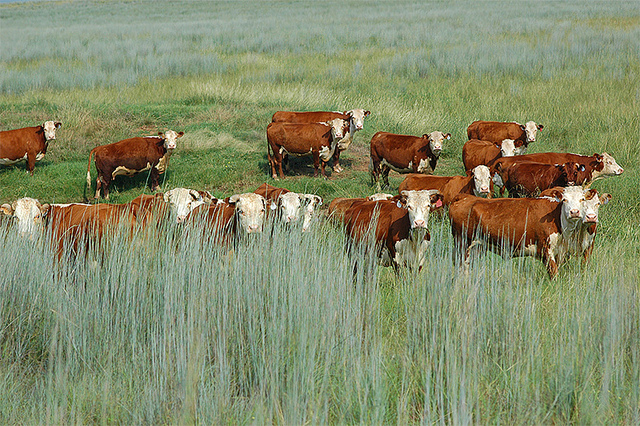
America’s grasslands are among our most productive natural resources, providing wildlife habitat, flood mitigation, erosion control, and helping to sequester an enormous amount of carbon dioxide. Moreover, grasslands are a critical component of our ranching and hunting economies.
Unfortunately, these lands are also some of the most threatened natural resources in the country. A study published last year in the journal Environmental Research Letters found that between 2008 and 2012, 1.6 million acres of 20+ year-old grasslands were torn up, primarily for crop production.
The loss of grasslands is one of the most significant threats facing grass-based livestock producers today. To combat the loss of this critical natural resource, the U.S. Department of Agriculture (USDA) operates several programs that help farmers and ranchers conserve and enhance grasslands. One of the most widely utilized USDA programs for grasslands conservation is the Conservation Reserve Program’s (CRP) Grasslands Initiative, which was created in the 2014 Farm Bill. The Grasslands Initiative helps farmers and ranchers conserve grazing lands, with priority given to: diverse, native grasslands; lands at high risk of conversion to cropland or development; lands that provide habitat for threatened or endangered species; and lands that are farmed by beginning, veteran, or underserved producers.
On Friday, November 4, USDA’s Farm Service Agency (FSA), which administers CRP, announced that up to 200,000 acres would be reserved for the enrollment of small, grass-based dairy operations that have 100 or fewer head of dairy cows. Operations that meet this and the general eligibility criteria for CRP Grasslands can apply to enroll up to 200 acres of grass. See our Grassroots Guide to Federal Farm and Food Programs for full eligibility information and other program details.
The deadline for smaller-scale dairy operations to sign up for this new opportunity is December 16, 2016. However, successful applicants will not actually be enrolled in the program until October 1, 2017, which is the start of the 2018 fiscal year (FY).
Small livestock operations or other farming and ranching operations interested in participating in CRP’s Grasslands Initiative should contact their local FSA office. To find your local FSA office, visit http://offices.usda.gov.
USDA will select offers based on the following factors:
- The existence of expiring CRP or Grassland Reserve Program land;
- The extent to which the cover is a diverse mix of native species;
- The extent to which the enrollment addresses resource concerns (e.g., threatened wildlife species or water quality) on priority grasslands identified at the state level;
- Whether the applicant is a beginning, veteran, or socially disadvantaged farmer or rancher and;
- Whether the applicant will establish pollinator habitat.
The CRP Grasslands Initiative is part of the continuous sign up, meaning that farmers and ranchers can sign up at any time. However, FSA does set “ranking periods” which allows the agency to batch, rank, and enroll applications that are submitted before certain dates. The ranking period associated with this announcement is the third ranking period; the current ranking period is the Initiative’s second and ends on Thursday, November 10. Last May, FSA announced that it had accepted 101,000 acres through the inaugural enrollment period of the Grasslands Initiative, primarily from large ranches in Nebraska and South Dakota, among other states. We expect FSA to make award announcements for the second ranking period soon after it closes on Thursday – perhaps as early as next week.
In last week’s announcement, Farm and Foreign Agricultural Services Deputy Under Secretary Alexis Taylor encouraged grazing operations to consider combining grassland practices with other continuous CRP practices, thereby creating a more holistic package of conservation activities that can help small livestock producers thrive:
“There also are ways that CRP Grasslands could be combined with other traditional CRP conservation practices, such as riparian buffers on the same farm, to create a package that can help keep small livestock operations in production. An example of such a package would be to dedicate the most sensitive land to conservation, while still maintaining the bulk of the area as working grasslands for livestock. USDA would provide cost-share assistance to help farmers install fencing and provide alternative water sources to livestock, as well as annual CRP payments to help the farm’s bottom-line.”
The National Sustainable Agriculture Coalition (NSAC) has long advocated for the use of conservation buffers through the continuous CRP sign up, and more generally for the adoption of suites of conservation practices on agricultural lands. We appreciate the Deputy Under Secretary’s comments and her focus on bundling practices and generating multiple benefits. We are, however, concerned that FSA has not made rotational or prescribed grazing a focal point of the Grasslands Initiative. Participants are required to implement a conservation plan that is “consistent with maintaining the health and viability of grassland resources,” however, there is no priority given to producers who use prescribed or rotational grazing systems to enhance grassland resources. Looking toward the next Grasslands Initiative enrollment, we will continue to work with FSA and its conservation-planning partner, the Natural Resource Conservation Service (NRCS), to ensure that farmers and ranchers are implementing more substantive conservation plans that support and encourage sustainable grazing systems.

